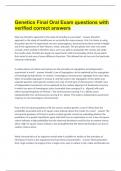Genetics Final Oral Exam questions with
verified correct answers
Why was Mendel's approach to the study of heredity so successful? - answer Mendel's
approach to the study of heredity was so successful for many reasons. First, his choice in using
the garden pea for his experiment was very advantageous, because these plants varied in height
and in the appearance of their flowers, seeds, and pods. The pea plants were also very easily
crossed, which worked in Mendel's favor, as he was able to manipulate the crosses and study
the results easily. Mendel also began his experiments with true-breeding strains of pea plants
that varied in only one of seven different characters. This allowed him to focus on that particular
character individually.
In which phases of mitosis and meiosis are the principles of segregation and independent
assortment at work? - answer Mendel's Law of Segregation can be explained by the segregation
of homologs during Meiosis. In meiosis I, homologous chromosomes segregate from each other.
Sister chromatids segregate in meiosis II, and this leads to the segregation of the alleles into
separate gametes. Each gamete contains one copy of each type of chromosome. Mendel's Law
of Independent Assortment can be explained by the random alignment of bivalents(a structure
in which two pairs of homologous sister chromatids have synapsed (i.e., aligned) with each
other) during Metaphase of Meiosis I. The chromosomes carrying Y or y alleles assort
independently from chromosomes carrying R or r alleles. This leads to independent assortment
of genes on non-homologous chromosomes.
How is the chi-square goodness of fit test used to analyze genetic crosses? What does the
probability associated with a chi square value indicate about the results of a cross? - answer The
chi-squared goodness of fit test is used to analyze genetic crosses by evaluating whether the
predictions of a genetic hypothesis agree with data from an experiment or not. A low chi square
values indicates a high probability that the observed deviations could be due to random chance
alone. High chi square values indicate a low probability that the observed deviations are due to
random chance alone.
What characteristics of an organism would make it suitable for studies of the principles of
inheritance? Name a few organisms that have these characteristics. - answer Short generation
time, large numbers of progeny from a single cross, easy to culture in lab, males and females are
, readily distinguished, having a relatively small genome, being large enough to be easily
observed with a dissecting microscope. Mice, flies, worms, frogs, yeast, zebrafish.
Explain Mendel's Laws to an educated non-scientist. - answer Mendel's law of independent
assortment: two different genes(or units of heredity) will randomly assort or group their
alleles(or alternative form of a specific gene) during gamete(or reproductive cell) formation (if
they are not linked).
Mendel's law of segregation: the two copies of a gene segregate(or separate) from each other
during transmission or transportation from parent to offspring.
Distinguish the following terms: chromosome, chromatin, sister chromatid, and homologous
chromosome. - answer chromosome: the structures within living cells that contain the genetic
material. Genes are physically located within the structure of chromosomes.
chromatin: the complex of DNA and proteins that is found within eukaryotic chromosomes
sister chromatid: pairs of replicated chromosomes that are attached to each other at the
centromere. Sister chromatids are genetically identical.
homologous chromosome: the two homologs of a chromosome pair are said to have similar
size, banding pattern, and genetic composition
Given three recessive traits, (1) explain how you would test for linkage; and (2) if you determine
all three traits to be linked, explain the general approach to calculating the map distance
between the loci. - answer Three recessive traits are green seed color, wrinkled seed shape, and
yellow pod color. To test for linkage, I would perform a three-factor cross, which is a cross in
which the experimenter follows the outcome of three different characters. First I would cross
two true-breeding strains that differ with regard to the three alleles for see color, seed shape,
and pod color. Then, I would perform a testcross by mating F1 female
heterozygotes to male individuals that are homozygous recessive for all three alleles. Then, I
would collect data for the F2 generation. If the genes assorted independently, all eight
combinations would occur in equal proportions. To determine linkage, I would then perform a
chi squared test to test the hypothesis that the characters are segregating and assorting
independently. If it is determined that all three traits are linked, I would then calculate the map
distance between the loci. I would regroup the data according to pairs of genes to calculate map
distance between two genes. I would then make a table in order to organize the total number of
parental offspring for the paired genes, and the total number of nonparental or recombinant
offspring with the paired genes. Then, using the formula for map distance which is ((number of
recombinant offspring)/(total number of offspring))*100, I would determine the map distance in




